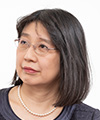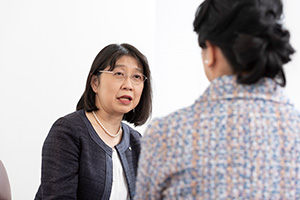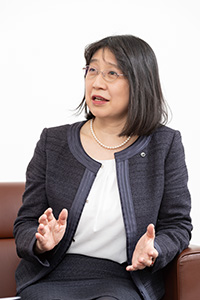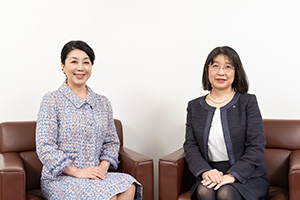 |
|
|
|
|
|
View from the Top Vol. 18, No. 3, pp. 1–5, Mar. 2020. https://doi.org/10.53829/ntr202003tp1
Promoting Communication with Digital Transformation and Applying Mutually Exclusive and Collectively Exhaustive PrincipleOverviewThe NTT Group is committed to solving social issues, and its initiatives and responsiveness have been highly evaluated. The Group joined the international environmental protection initiatives EP100 and EV100 as their first telecommunications carrier member. It has also been selected as a global top innovator for the eighth consecutive year. We asked Atsuko Oka, NTT senior vice president, head of Technology Planning, for her 2020 outlook for the NTT Group, which strives to provide high-quality, highly reliable services for safe and secure operation of information and communication technology infrastructure. Keywords: digital transformation, IOWN, MECE Providing reliable communication infrastructure as Your Value Partner—What kind of year was 2019? In 2019, typhoons Faxai and Hagibis hit the Japanese archipelago in quick succession and caused severe damage in many areas due to strong winds and river flooding. I’d like to express my deepest sympathies to all those affected. About 80,000 communication lines were affected. While NTT was working to restore telecommunications services, which is a social infrastructure, I strongly felt that we need to consider strengthening our resilience (namely, ability to recover from disasters and failures)—starting with quick recovery—and further strengthen dissemination of information. We have thus begun efforts to (i) predict the impact on communication facilities from the path and intensity of a typhoon and (ii) prepare in advance people and materials necessary for restoration near areas where damage is expected. Since those efforts are based on prediction, they may end up in vain. Even so, from the standpoint of a telecommunications carrier, quick recovery is our top priority, and I think it is too late to start responding after a disaster. To make it possible to quickly restore the infrastructure, we are making full use of artificial intelligence and other technologies developed by NTT laboratories to predict the occurrence of disasters and respond proactively to them. I thought it was necessary to disseminate not just information about disasters affecting our communication facilities but also information about what kind of services NTT provides, what kind of equipment is used for those services, what state the equipment is in, and what recovery activities are ongoing. Major international events are increasingly being held in Japan, so many visitors come to participate in and watch these events. Web services and social networking services are not only supported in Japanese but also in English and many other languages. Since such events are becoming ever more regular, it is important to ensure stable communication and tight security so that they run smoothly and companies operate normally. The Security Strategy Section of the NTT Technology Planning Department is carrying out early detection, analysis, and response and investigating technology for early defense regarding cyber threats. As the saying goes, “Being prepared means peace of mind;” thus, for stable provision of communication, we want to proactively respond to anything by paying attention to details. —It is encouraging just to hear that. How will you tackle this challenge in 2020? NTT announced a medium-term management strategy called Your Value Partner in November 2018. The pillars of this strategy are twofold: promoting our own digital transformation (DX) and supporting our customers’ DX. This strategy is a major mission for us. Although DX sounds like pursuing cost reduction and efficiency, by freeing up more time for people through DX, it will help to reform work styles such as reducing overtime work, enhance communication, and promote open innovation. For example, in the case of a business that conventionally uses paper, digitizing the entire business process and distributing digitized information will accelerate the entire process. This digitization will speed up the provision of services to customers, thereby improving customer satisfaction and customer experience. Moreover, we are aiming to increase profits by providing customers—as a future solution service—with actual examples of us promoting DX and making things more convenient. We are already conducting activities in each field. We have launched a cloud-based billing platform called Smart BillingTM and are proposing a cloud-based contract-management platform called Smart Fulfillment to corporate customers. With customers seeming to be actively working on DX, we are often asked to tell them about what we are promoting at NTT. As customer DX proceeds, companies and individuals will change their work styles, and communication with people they haven’t spoken to before will increase further. As a result, open innovation will progress.
—It seems that a new world can be opened up by changing the way we use time. Looking to the future, we are promoting the Innovative Optical and Wireless Network (IOWN), a next-generation communication infrastructure that is being targeted for practical use around 2030. The IOWN Global Forum, a new industry forum for achieving IOWN, has already been registered as a corporation, and NTT, Sony, and Intel have been appointed as initial board members. More than 100 companies in Japan and around the world, including Microsoft, Verizon, Orange, and China Telecom, have shown interest in joining. The response to setting up the forum was faster from outside Japan. Until recently, the concepts that NTT has launched have often been disseminated only within Japan. However, the positive reaction from global companies to IOWN can be attributed to the establishment of new global bases including NTT Research, Inc. in the United States, strong interest in the All-Photonics Network, the key element of IOWN that introduces optical technology end-to-end from the network to the terminal, and the expectation of IOWN as a solution to issues such as limitations of semiconductor devices concerning low-power consumption and high-speed transmission. The NTT Technology Planning Department will continue introducing, operating, and maintaining new technologies developed in our research laboratories as well as outside ones while formulating and implementing measures related to disaster countermeasures, security, and efficient procurement of equipment. When the technologies, new services, and businesses that make up IOWN become concrete, we will also consider the grand design of a network suitable for IOWN as well as a migration plan for gradually migrating from existing networks to the All-Photonics Network.
“Practice makes perfect”—Please tell us what you value in carrying out your mission. “Practice makes perfect” is my favorite phrase. I believe that we will be able to handle almost anything if we do things seriously and steadily. Also, my maxim is be timely; I am often the first to arrive at meetings. Other attendees arrange their schedules to fit meetings into their busy schedules; in other words, they reserve their precious time for meetings. Many, however, can barely fit meetings into their schedules. Time is lost when time is not kept. Today, time can be bought with money, such as when we use electrical appliances to cut down on time consumed by household chores; however, I don’t think face-to-face communication and getting involved with challenging tasks can be bought. I feel that precious time should not be wasted. I take notes at work and keep a personal diary. I don’t write much and it’s not well organized, but sometimes I notice things when I look back. I don’t think we can rely on memory alone. The beginning of this habit dates back to my college days. Attending a combined junior and high school, the people around me were all old friends, but when I entered university, the people around me were all new. At first, in an environment where I had nobody to rely on, I realized I could rely on only myself and started taking copious notes for my classes. When I lent my notes to classmates before tests, those notes kept circulating among the students; thus, I contributed in some way to the student community. This continued into my professional life. After joining NTT, I went to work at an affiliated organization, and I kept taking notes, even though my team didn’t have the habit of doing so, and they eventually used my notes. Therefore, it can be said that the notes and memos I took for myself contributed to my work. I also maintain a conscious attitude based on the MECE (mutually exclusive, collectively exhaustive) principle. If you focus too much on your task, you won’t see the whole picture, and you will be worried that you are missing something. However, if you take a step back and look at the whole picture again from a slightly higher viewpoint, you may notice an omission, so I work while being aware of MECE. It is important to categorize each task by creating a framework to understand the whole picture. This will help reduce unnecessary meetings and redundancy in my work. I only got into this habit after starting my professional life. I may have picked it up when I was working at the Corporate Planning Department of NTT Communications. I felt guilty if I had to ask for something again because of my narrow or lack of vision. —You can learn from anything and apply what you learned to future tasks! Please tell us about any turning points you encountered. When I joined NTT, I was assigned to Software Research Laboratories, where I was engaged in research related to the Internet. The sudden transfer to the International Business Department changed my mindset, and it seems to me now that it was a turning point. In the 1990s, the Prime Minister of Malaysia, Mahathir bin Mohamad, gave his vision for a full-fledged information society arriving in the 21st century, which he called the multimedia super corridor (MSC), which would be achieved while competing against developed countries around the world. After the MSC project was launched, NTT received a request for cooperation, and I was transferred to the International Business Department to participate in that project. At that time, I was very worried because I could not speak adequate English. Although I had some experience in presenting my research at conferences, I had no experience in promoting NTT technologies outside Japan or working with people from different countries to create concepts, so I asked myself “what should I do?” When I started working on the MSC project, however, I realized that NTT’s technologies were outstanding and was driven by the desire to promote those technologies, so I felt I was moving forward. I also thought that if I did not present such technologies effectively, other people would not understand them, and communication was the key to that understanding. On top of that, I realized that it is necessary to have a marketing mindset like that taught in business schools. Unexpectedly, this challenging time turned into an opportunity. I faced another turning point in 1999. I studied abroad and learned business basics and skills to develop business from technology. Through my experiences studying abroad and in Malaysia and working with multinational team members on projects, I cultivated diverse perspectives and communication skills and recognized the importance of the spirit of contribution.
“A feeling of being worthwhile” gained by working hard—What does “work” mean to you? To me, work naturally means working hard and getting paid, but at the same time, it means changing the world through the results of our work and satisfying our customers with the services we provide. As I said, my work hasn’t always gone smoothly. For example, moving to the International Business Department and participating in the Malaysian project may have been a setback in some ways, including a language barrier. However, there is always a way; we are not working alone. One of the great things about joining NTT is that someone always helped me, and I am very grateful for that help. I tried to find a role model. However, it is not easy to find people with similar backgrounds or in similar situations. Therefore, I’ve been trying to find a good role model by “cherry picking” when interacting with various people. Sometimes I wonder if my activities will be helpful to younger women. In fact, the number of women in managerial positions is increasing, so I want to observe their work style and performance and “pick” the best of them and take on further challenges. —Please say a word to researchers and engineers inside and outside the company. I originally got involved in technology as a researcher. Technology does not always take shape immediately and lead to business. Sometimes it takes shape after some time, maybe even after 20 years. The first thing I did after returning from studying abroad was help launch a video-distribution service. At that time, said to be the first year of broadband, most video distribution was 64-kbit/s quality. However, various technologies have been combined, and now we have reached 5G (fifth-generation mobile communications), which allows us to enjoy stunning images on smartphones. Some technological developments produce results immediately, while others blossom with time. Accordingly, it is important to make the research and technology that we are working on open through communication with the rest of the world. Unlike in the past, information can now be transmitted in many ways, such as via the web, and the importance of open innovation and co-working is increasing. That’s why integrity is fundamental when it comes to making things open as well as communicating and connecting with people. Interviewee profileCareer highlightsAtsuko Oka joined Nippon Telegraph and Telephone Public Corporation (now NTT) in 1988. After serving as the director of the IP Services Department of the Net Business Division of NTT Communications from 2006 to 2010, she became the president and CEO of NTT NaviSpace in 2010 and served as a board member and general manager of the Solution Business Division of NTT Resonant from 2017 to 2019. She assumed her current position in June 2019. |
|












